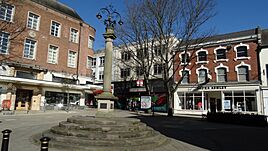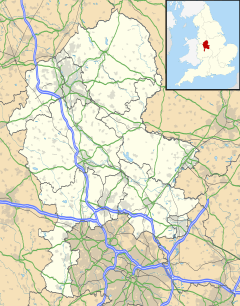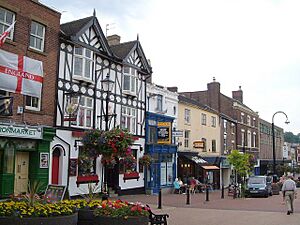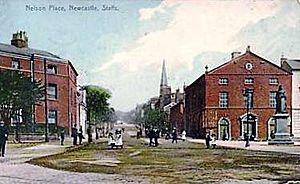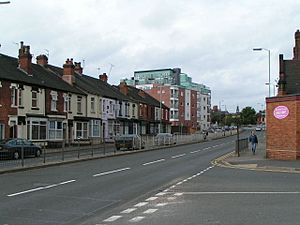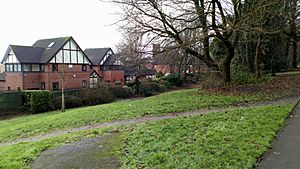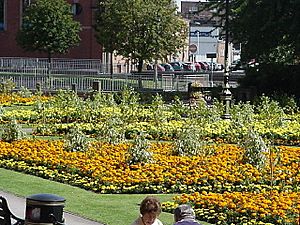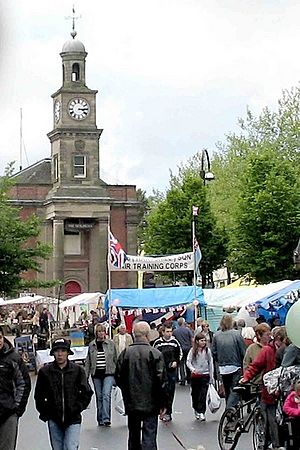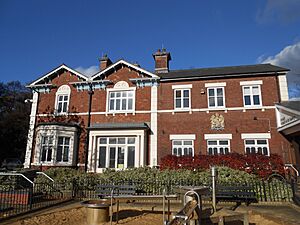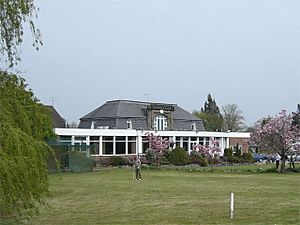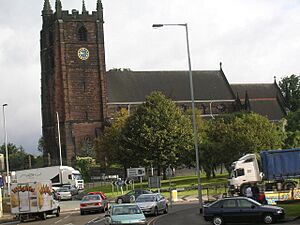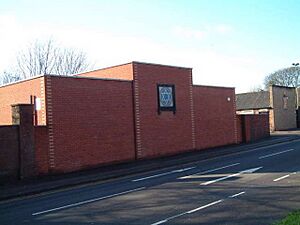Newcastle-under-Lyme facts for kids
Quick facts for kids Newcastle-under-Lyme |
|
|---|---|
|
|
| Population | 75,082 (2021 census) |
| OS grid reference | SJ848459 |
| District |
|
| Shire county | |
| Region | |
| Country | England |
| Sovereign state | United Kingdom |
| Post town | NEWCASTLE |
| Postcode district | ST5 |
| Dialling code | 01782 |
| Police | Staffordshire |
| Fire | Staffordshire |
| Ambulance | West Midlands |
| EU Parliament | West Midlands |
| UK Parliament |
|
Newcastle-under-Lyme is a busy market town in Staffordshire, England. It's the main town of the Borough of Newcastle-under-Lyme. The town is right next to the city of Stoke-on-Trent. In 2021, about 75,082 people lived there.
Newcastle started growing in the 1100s around a castle. This castle gave the town its name. It received its first official document, called a charter, in 1173. In the past, the town was known for making hats, weaving silk, and coal mining. Even though it was close to the Staffordshire Potteries, it didn't become famous for making pottery.
Contents
- The Town's Name: What Does It Mean?
- A Look Back in Time: Newcastle's History
- What Newcastle Makes: The Economy
- Famous People: Politicians and Activists
- Getting Around: Transport in Newcastle
- Where It Is: Geography of Newcastle
- Who Lives Here: Demographics
- Learning and Growing: Education
- Fun Places to Visit: Sites and Attractions
- Arts and Entertainment: Culture in Newcastle
- News and Sounds: Media
- Staying Active: Sport
- Places of Worship: Religion
- Global Connections: International Network
- Notable People from Newcastle-under-Lyme
- Images for kids
- See also
The Town's Name: What Does It Mean?
The name "Newcastle" comes from a castle built in the mid-1100s. This was a "new castle" that replaced an older one nearby. It was built after King Stephen gave land to Ranulf de Gernon, 4th Earl of Chester. This was a reward for his help during a civil war called The Anarchy.
The word Lyme is found in many local names, like Lyme Brook and the Forest of Lyme. This word comes from an old British language. It means "elm tree." Long ago, elm trees covered a huge area across what are now Cheshire, Staffordshire, and parts of Derbyshire.
A Look Back in Time: Newcastle's History
Early Days: From Castles to Charters
Newcastle wasn't mentioned in the Domesday Book of 1086. This is because it grew up around a castle built in the 1100s. But it quickly became important. King Henry II gave the town a special charter in 1173. This new castle took over from an even older fort at Chesterton, about 2 miles (3.2 km) north.
In 1235, King Henry III made Newcastle a "free borough." This gave the town and its people special rights and freedoms. Later, in 1251, he rented it out to the town's citizens. The castle itself slowly disappeared over time. By the late 1500s, only one large tower was left.
Newcastle didn't play a big role in the English Civil War. It mostly suffered from Royalist soldiers taking things. However, it was the home of Major General Thomas Harrison. He was an army officer who supported Oliver Cromwell.
In 1816, a law changed how common lands in the town were used. This meant that the rights to use these lands were held in trust for the town's citizens. This trust still exists today. In 1835, new laws changed how the town was governed. The old "Mayor, Bailiffs and Burgesses" became the "Mayor, Aldermen and Burgesses."
Newcastle sent two members to Parliament from 1355 until 1885. Then, it lost one of its seats.
The 1900s: Staying Independent
When Stoke-on-Trent was formed in 1910, by joining six nearby towns, Newcastle decided to stay separate.
Even though it was very close, Newcastle wasn't directly involved in the pottery industry. It strongly opposed joining Stoke-on-Trent in 1930. A survey showed that 97.4% of residents were against the idea. The plan passed in the British House of Commons but was rejected by the House of Lords.
After a new local government law in 1972, Newcastle became the main town of the Borough of Newcastle-under-Lyme.
What Newcastle Makes: The Economy
Like its neighbour Stoke-on-Trent, Newcastle's early economy focused on making hats, silk, and cotton mills. Later, coal mining, making bricks, iron casting, and engineering became important. Some fine pottery was made in Newcastle between 1724 and 1754, but this stopped. After that, there wasn't much pottery made in the town itself, except for some earthenware tiles.
Making clay tobacco-smoking pipes started around 1637. This industry grew very fast. It became the second most important industry after hat-making. Newcastle was one of the four biggest pipe producers in the country. But by the mid-1800s, this industry quickly declined. By 1881, only one pipe maker was left.
In the 1600s, 1700s, and 1800s, the town had a thriving felt hat industry. It was probably at its busiest in the 1820s. At that time, one-third of the town's people worked in over 20 hat factories. But by 1892, only one factory was still making hats.
In 1944, the Rolls-Royce Derwent engine, used in the Gloster Meteor fighter jet, was made in the borough.
In the 1900s, Newcastle's industries included: working with iron, making building materials, clothing (especially uniforms), computers, publishing, and making electric motors and machinery.
Around the year 2000, the town centre was redeveloped. A new street called Castle Walk was added. This brought a new bus station and more businesses to the town. Many offices for companies that provide services are now in the town's business centres.
Since 2015, the town has been classed as a BID (Business Improvement District). This means local businesses work together to improve the area.
Famous People: Politicians and Activists
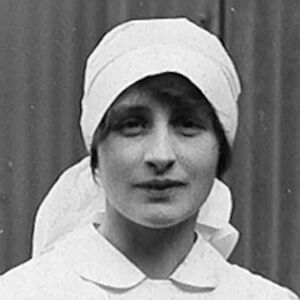
Many notable politicians and activists were born in Newcastle. Fanny Deakin worked to improve food for babies and children. She also campaigned for better care for mothers. Janet Bloomfield was a leader of the Campaign for Nuclear Disarmament (CND). She worked for peace and disarmament. Vera Brittain, a writer and feminist, was also born here. She was the mother of Shirley Williams, a famous politician.
Two very important Members of Parliament (MPs) came from Newcastle. Josiah Wedgwood IV was an MP for many years, from 1909 to 1942. He was a member of the Liberal and Labour parties. He even served as a minister in the first Labour government. John Golding was elected as a Labour MP for Newcastle-under-Lyme in 1969. He served in government roles, including Minister for Employment.
The current MP for Newcastle-under-Lyme is Adam Jogee.
Getting Around: Transport in Newcastle
The town used to have a North Staffordshire Railway station. This station was on a line that went from Stoke-on-Trent through Newcastle, Silverdale, and Keele, all the way to Market Drayton. Newcastle-under-Lyme railway station opened in 1852. It had two tunnels nearby.
The railway line closed to passengers in 1964. Only small parts remained for coal trains. The section from Newcastle Junction to Silverdale has been removed. The old station site and tunnels are now filled in. This area is called "Station Walks."
Newcastle was also part of the national canal network. The Newcastle-under-Lyme Canal connected to the Trent and Mersey Canal. But it stopped being used in 1935 and most of it has been filled in.
Today, people in Newcastle mostly use buses for public transport. FirstGroup runs many bus services. These connect Newcastle to the towns of the Potteries and to Stafford. Arriva buses go to Shrewsbury via Market Drayton.
The M6 motorway runs south and west of Newcastle. The A500 road is to the north and east. You can get onto the M6 at junctions 15 and 16. The A34 is a main road that goes through Newcastle from north to south. It used to be the main road between Birmingham and Manchester before the M6 motorway opened. There is a large bus station in the town centre.
The closest train station to Newcastle is Stoke-on-Trent railway station. This station serves the whole Potteries area. Newcastle is the third-largest town in England (by population) that does not have its own railway station.
Where It Is: Geography of Newcastle
Newcastle is in a valley next to the Lyme Brook. It is just west of Stoke-on-Trent, and their suburbs blend together. Newcastle town centre is less than 4 miles (6.4 km) from Stoke-on-Trent City Centre. It's about 17 miles (27 km) north of Stafford and 5 miles (8.0 km) south of the Cheshire county border. The Shropshire county border is about 10 miles (16 km) away.
Protecting Green Spaces: The Green Belt
Newcastle and Stoke form the main urban area in the middle of the Stoke-on-Trent Green Belt. This is a special area that protects the countryside in Staffordshire. It helps stop towns from spreading too much and keeps them separate from smaller villages. The Green Belt was first set up in 1967. Most of it is in the wider borough. Some important places and natural features are covered by or surrounded by it. These include Keele University, Newcastle golf course, and Apedale Community Country Park.
Caring for the Environment
Newcastle-under-Lyme Borough Council works on many projects to help the environment. They have a plan called the Sustainable Environment Strategy. As part of this, they turn household and business waste into energy. They also helped develop Blue Planet Chatterley Valley. This is a sustainable logistics facility built on an old colliery site. The Council also works with other groups to manage the Walleys Quarry landfill site in Silverdale.
Who Lives Here: Demographics
| Comparative Census Information | |||
|---|---|---|---|
| 2001 UK Census | Newcastle-under-Lyme | Borough | England |
| Total population | 73,944 | 122,030 | 49,138,831 |
| White | 97.8% | 98% | 91% |
| Asian | 0.6% | 0.6% | 4.6% |
| Black | 0.2% | 0.2% | 2.3% |
| Christian | 78.2% | 78.5% | 72% |
| Muslim | 0.7% | 0.5% | 3.1% |
| Hindu | 0.2% | 0.2% | 1.1% |
| No religion | 14% | 13.1% | 15% |
| Unemployed | 2.3% | 2% | 3.3% |
In the 2001 census, 73,944 people lived in Newcastle. About 51.7% were female and 48.3% were male. Most people (78.2%) said they were Christian. About 12.9% said they had no religion. Other religions like Islam, Judaism, Buddhism, and Sikhism each made up less than 1% of the population. Most people (97.8%) identified as white.
When it came to jobs, 62.2% of people worked full-time and 19.4% worked part-time. The biggest types of jobs were in manufacturing (21.5%), wholesale and retail (18.7%), health and social work (12.5%), and finance, real estate, and business (11.6%).
Jewish people have lived in the area since the 1800s. In 1873, they bought an old chapel to use as a synagogue. A new synagogue was built in Hanley in 1923. This closed in 2004, and the congregation moved to a smaller synagogue in Newcastle.
Learning and Growing: Education
Newcastle has a private school called Newcastle-under-Lyme School. It was started in the 1600s. Famous former students include T. E. Hulme and John Wain. The town also has many primary and secondary schools that are funded by the state. These include Newcastle Community Academy, Clayton Hall Academy, and St John Fisher Catholic College. There is also a private school called Edenhurst Preparatory School.
The town's largest college for students aged 16 and over is Newcastle-under-Lyme College. It was established in 1966.
Keele University's main campus is about 3 miles (4.8 km) from the town centre.
Fun Places to Visit: Sites and Attractions
Green Spaces: Parks and Gardens
In 2005, Newcastle won a national award for its "small city/large town" category (for towns with 35,000–100,000 people). The town has several parks. Queen's Gardens, at the east end of Ironmarket, won an award for its excellent gardening in 2003. It has a statue of Queen Victoria. This is the only park inside the town's main ring road.
Grosvenor Gardens is in the middle of a roundabout, but it's hidden below the road. Queen Elizabeth Garden is outside the town centre and is being improved with money from the National Lottery Heritage Fund.
To the north-west of the town centre is Brampton Park. This park is home to a museum and art gallery.
Shopping and History: The Traditional Market
Newcastle's market, known as the Stones, has been around since 1173. It operates on the High Street. The market used to be on Sundays, then Saturdays, and later Mondays. Kings and Queens also gave permission for fairs to be held here.
Today, the market is open six days a week and has over 80 stalls. On Mondays, Wednesdays, Fridays, and Saturdays, it's a general market. Tuesdays have an antiques market, and Thursdays sell bric-a-brac (miscellaneous items). A market for cattle and other livestock used to be held on Mondays until the early 1990s. That site is now a Morrison's supermarket.
The Guildhall: A Historic Building
The current Guildhall was built in 1713. It has changed over the years. Originally, the ground floor was open and used for markets. In 1860, the arches on the ground floor were bricked up to create more space. A clock tower with four clocks was also added. The top rooms in the Guildhall were used for meetings by the town council. It is now a Grade II listed building, meaning it's an important historic building.
The Barracks: Military History
The Italian-style Militia Barracks were built in 1855 using red bricks. They were the main base for a local army regiment until 1880. Later, in 1882, the Barracks were bought and set aside for use by local volunteer soldiers. In 2002, the Barracks were rented out to small businesses.
Arts and Entertainment: Culture in Newcastle
The New Vic Theatre is a special kind of theatre called a "theatre in the round." This means the audience sits all around the stage. It's just outside the town centre and shows modern and classic plays, as well as concerts.
The Borough Museum and Art Gallery (Brampton Museum) tells the story of the town's history. It even has a life-size Victorian street scene. The art gallery displays work by local and national artists, and also hosts traveling exhibitions.
Many famous people from Newcastle have contributed to arts and entertainment. Philip Astley is known as the founder of the modern circus. Jackie Trent, a singer and songwriter, was born in the town. Arnold Bennett, a famous novelist, went to school here. He called the town "Oldcastle" in some of his books. Dinah Maria Mulock, a writer, also lived and went to school in Newcastle.
E. S. Turner, a social commentator, was educated in the town. Dr Philip Willoughby-Higson, a poet and historian, lived in Newcastle. He founded the Chester Poets, an old poetry group.
News and Sounds: Media
You can get regional news and TV programmes from BBC West Midlands and ITV Central. TV signals come from transmitters in Fenton or Sutton Coldfield. You can also sometimes get BBC North West and ITV Granada from the Winter Hill transmitter.
Local radio stations include BBC Radio Stoke, Hits Radio Staffordshire & Cheshire, Greatest Hits Radio Staffordshire & Cheshire, HitMix Radio, and 6 Towns Radio.
The Sentinel is the town's local newspaper.
Staying Active: Sport
Newcastle has many sports clubs. Newcastle Town F.C. is a football club that plays in the Northern Premier League. Rugby is played by Newcastle Staffs Rugby Union Club.
Cycle Staffordshire and the Newcastle Track Cycling Association organize local cycling events. The town has a velodrome (a track for cycling) used by the Lyme Racing Club.
Newcastle Athletic Club is based at the Ashfield Road track. This track was built in 1964. The club competes in various leagues.
The town is home to the Newcastle (Staffs) Volleyball Club. It was started in 1980 and has teams in the National Volleyball League.
Newcastle-under-Lyme College is home to Castle Korfball Club. This is one of the oldest Korfball clubs in the country. It was founded in 1996.
Newcastle (Staffs) Swimming Club was founded in 1908.
There are golf courses in Kidsgrove, Wolstanton, Keele, and Westlands.
Keele University has one of the UK's first quidditch teams, called the Keele Squirrels. They hosted the first ever quidditch game in the UK in 2011.
Places of Worship: Religion
The town was the birthplace of John James Blunt, an Anglican priest. Josiah Wedgwood was a Unitarian. He and his family attended meetings at the Old Meeting House, which is still used today.
The town has several Anglican churches, including St Giles. This is a medieval parish church that dates back to 1290. There are also several Catholic churches. Holy Trinity is known for its Gothic style.
In the 1700s, John Wesley visited the area many times. He helped many people join Methodism. This is why there are several Methodist churches in the town. There is also a Baptist church in Clayton.
The the Church of Jesus Christ of Latter-day Saints (LDS Church) is across from Brampton Park. It serves as a main centre for the church in the region. It also has a Family History Centre where anyone can research their family history for free or at low cost.
Global Connections: International Network
Newcastle-under-Lyme is part of a worldwide group of towns and cities named Newcastle. This includes the well-known Newcastle upon Tyne in England. Other towns in this network are Neuburg an der Donau (Germany), Neuchâtel (Switzerland), Neufchâteau (France), and several in the United States: New Castle, Indiana, New Castle, Pennsylvania, and New Castle, Delaware. There's also Newcastle, KwaZulu-Natal (South Africa) and Shinshiro (Japan).
This small international network of eight towns was formed in 1998. Its goal is to encourage friendship and cooperation between them. For example, in 2004, a school in the South African town received computer equipment that Newcastle-under-Lyme no longer needed. The yearly Newcastles of the World Summit was held in Newcastle-under-Lyme for six days in June 2006.
- Neuburg an der Donau, Germany
- Neuchâtel, Switzerland
- Neufchâteau, France
- New Castle, Delaware, United States
- New Castle, Indiana, United States
- New Castle, Pennsylvania, United States
- Newcastle upon Tyne, England
- Newcastle, KwaZulu-Natal, South Africa
- Shinshiro, Japan
Notable People from Newcastle-under-Lyme
From the 1600s and 1700s
- Philip Astley (1742–1814), a horse rider and the inventor of the modern circus.
- Silvester Harding (1745–1809), an artist and publisher.
From the 1800s
- Henry Moseley (1801–1872), a churchman, mathematician, and scientist.
- Emma Darwin (née Wedgwood) (1808–1896), granddaughter of Josiah Wedgwood and wife of Charles Darwin.
- Sir Oliver Lodge (1851–1940), a physicist, inventor, and writer.
- Sir Joseph Cook (1860 in Silverdale – 1947), worked in local coalmines. He later became Prime Minister of Australia.
- Arnold Bennett (1867–1931), a famous writer who went to school in Newcastle.
- Fanny Deakin (1883–1968), a local politician who campaigned for better child and maternity care.
- Vera Brittain (1893–1970), an author, reformer, and pacifist.
- Reginald Mitchell (1895–1937), the designer of the famous Spitfire fighter plane.
From the 1900s
- Jackie Trent (1940–2015), a singer, songwriter, and actress.
- Neil Baldwin (born 1946), known as a clown and for working with Stoke City F.C..
- Janet Bloomfield (1953–2007), a peace and disarmament campaigner.
- Hugh Dancy, (born 1975), an actor known for his role in the TV series Hannibal.
- Charlotte Salt, (born 1985), an actress known for her role in Casualty.
- Dan Croll (born 1991), a singer-songwriter.
- John Wain (1925-1994), an author, playwright, and poet.
Sports Personalities
- Dick Ray (1876–1952), a professional footballer and manager.
- Don Ratcliffe (1934–2014), a footballer for Stoke City F.C..
- Mike Pejic (born 1950), a footballer for Stoke City and Everton F.C..
- Robbie Earle (born 1965), a footballer for Port Vale and Wimbledon F.C..
- Dominic Cork, (born 1971), a famous cricketer.
- Simon Wakefield (born 1974), a professional golfer.
- Lizzie Neave (born 1987), a slalom canoeist who competed in the 2012 Summer Olympics.
- Eddie Hall (born 1988), a professional strongman.
- Danielle Wyatt (born 1991), a professional England cricketer.
- Curtis Nelson (born 1993), a footballer for Plymouth Argyle F.C..
Images for kids
See also
 In Spanish: Newcastle-under-Lyme para niños
In Spanish: Newcastle-under-Lyme para niños


